 Boolean
Boolean
Introduction
This topic will explain the Boolean function, will explain where to find the function, and explain the options found in it. This topic will also explain creation with quick steps and examples, and provide links to related topics.
The Boolean Functions
The Boolean function gives you access to several functions; Add, Subtract,
and Intersect. Each of these options provide a different way to handle
the interaction between solids and surfaces. This topic explains each
of the functions.

|

|

|
Navigation
To open Boolean, do one of the following:
- In the Solid Boolean group, of the Create 3D ribbon, click the
 Boolean.
Boolean. - In the Solid Boolean group, of the Create 3D ribbon, click the down arrow under
 Boolean, and select:
Boolean, and select: Add
Add Subtract
Subtract Intersect
Intersect
The Boolean parameters display in the Data Entry Manager.
Note: Whether you click the main icon, or the down arrow to get to the other options, you will have access to the same options in the Data Entry Manager.
The Data Entry Parameters
 Type
Type
![]() Add - The
Add function joins two or more solids or surfaces together in a boolean
operation. To perform the function, you select the entities in any order,
and then press the Spacebar to confirm the selections. After performing
the function, the entities can then be selected as a single entity.
Add - The
Add function joins two or more solids or surfaces together in a boolean
operation. To perform the function, you select the entities in any order,
and then press the Spacebar to confirm the selections. After performing
the function, the entities can then be selected as a single entity.
|
Solid/Surface Bodies to Union Together |
|
|
|
|
| The Solid/Surface Bodies to Union Together list box will list the entities currently selected for the function to add togehter. | |
![]() Subtract - The
Subtract function removes the intersecting area of one solid or surface
from another in a boolean operation. You can select any number of solid
or surface entities for the function, but the first selection must be
the entity that you want to keep and the entities must intersect each
other.
Subtract - The
Subtract function removes the intersecting area of one solid or surface
from another in a boolean operation. You can select any number of solid
or surface entities for the function, but the first selection must be
the entity that you want to keep and the entities must intersect each
other.
|
Main Solid/Surface Body |
|
|
|
|
| The Main Solid/Surface Body list box will list the entities currently selected for the function to subtract from. | |
|
Solid/Surface Bodies to Subtract |
|
|
|
|
| The Solid/Surface Bodies to Subtract list box will list the entities currently selected for the function to subtract. | |
![]() Intersect - The
Intersect function is a boolean operation that combines two or more solids
or surfaces keeping only the overlapping portion of both as a single solid.
You can select more than two surfaces or solids when using this function.
To perform the function, you select the entities in any order, and then
press the Spacebar to confirm the selections.
Intersect - The
Intersect function is a boolean operation that combines two or more solids
or surfaces keeping only the overlapping portion of both as a single solid.
You can select more than two surfaces or solids when using this function.
To perform the function, you select the entities in any order, and then
press the Spacebar to confirm the selections.
Important: This function finds the intersection of all the selected solids/surfaces. It does not find all intersections. For instance, if each selected entity does not intersect all other selected entities, nothing will be kept.
|
Solid/Surface Bodies to Intersect |
|
|
|
|
| The Solid/Surface Bodies to Intersect list box will list the entities currently selected for the function to add togehter. | |
- Show Preview / Hide Preview
Once geometry has been added to the Selected Geometry list, selecting this toggle will enable, and disable the CAD preview, which displays the result that will be created when you click OK.
- OK - performs the function after geometry selection.
- Cancel - cancels the function when finished.
Quick Steps
Quick Steps - Boolean Add
-
Open the function.
Focus is automatically on the Solid/Surface Bodies to Union Together list. -
Select all solid or surface entities that you want to add together into a single solid entity. The order of the selection does not matter.
-
You can press Spacebar, click
 , or click OK in the Data
Entry tab to confirm the selections.
, or click OK in the Data
Entry tab to confirm the selections.
The feature is added to the CAD Tree.
The entities are added and can now be selected as a single entity.
You can repeat this process as many times as needed. -
To close the function when you are finished, click Cancel.
Quick Steps - Boolean Subtract
-
Open the function.
Focus is automatically on the Main Solid/Surface Body list. -
Select the solid or surface a portion is being removed from.
Once an entity is added to the Main Solid/Surface Body list, focus is automatically shifted to the Solid/Surface Bodies to Subtract list. -
Select the solids or surface bodies to subtract.
-
Click Show Preview, to see a preview of the end result.
-
You can press Spacebar, click
 , or click OK in the Data
Entry tab to confirm the selections.
, or click OK in the Data
Entry tab to confirm the selections.
The feature is added to the CAD Tree.
The entities are subtracted, and the remainder of the Main Solid/Surface Body is left.
You can repeat this process as many times as needed. -
To close the function when you are finished, click Cancel.
Quick Steps - Boolean Intersect
-
Open the function.
Focus is automatically on the Solid/Surface Bodies to Intersect list. -
Select the intersecting solids or surfaces.
-
Click Show Preview, to see a preview of the end result.
-
You can press Spacebar, click
 , or click OK in the Data
Entry tab to confirm the selections.
, or click OK in the Data
Entry tab to confirm the selections.
The feature is added to the CAD Tree.
The intersection of the selected entities is left.
You can repeat this process as many times as needed. -
To close the function when you are finished, click Cancel.
Examples
Example Boolean Add
This example will demonstrate how to use the Boolean Add function.
Note: In the images below, both the Show Axis X-Y and Show Gnomon toggles have been disabled in the Axis X-Y group of the Settings Part > Display dialog.
-
In the Quick Access Toolbar, click
 New.
New.
A new document opens. -
Enter into an ISO 2 view by pressing Ctrl+7.
-
In the Primitives group, of the Create 3D tab, click
 Cube.
Cube.
The Cube parameters display in the Data Entry Manager.
The Preview appears.
-
The first cube being created will be left at the default size, and location.
Click OK to confirm the first cube.
The Cube is created in the graphics area and a Cube feature is created in
the
Cube feature is created in
the  CAD
Tree.
CAD
Tree.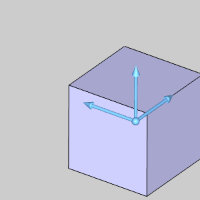
-
In the Origin group, change the values to X-1.0000, Y1.0000, Z1.0000.
The Preview updates.
-
Click OK to confirm the second cube.
The Cube is created in the graphics area and another Cube
feature is created in the
Cube
feature is created in the  CAD Tree.
CAD Tree.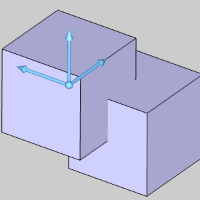
-
In the Corners group, of the Create 3D tab, click
 Solid Fillet.
Solid Fillet.
The Solid Fillet parameters display in the Data Entry Manager. -
In the Solid Fillet parameters, click Whole Solid.
This will allow us to apply the fillet to every edge of the solid at once. -
Hover over the first cube as seen in the image below.
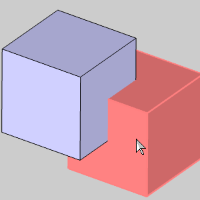
-
Click the cube to select it.
The cube is selected.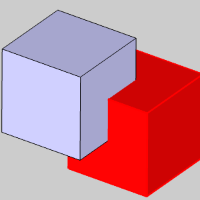
-
Click OK to confirm the fillet.
The fillet is created and a SolidFillet
feature is created in the
SolidFillet
feature is created in the  CAD Tree.
CAD Tree.
-
In the Solid Boolean group, of the Create 3D ribbon, click the down arrow under
 Boolean, and select
Boolean, and select  Add.
Add.
The Boolean parameters display in the Data Entry Manager.
Add is automatically selected as the function in use.
The Solid/Surface Bodies to Union Together list is automatically given focus to allow selection of the surfaces or solids to combine. -
Hover over the first cube as seen in the image below.
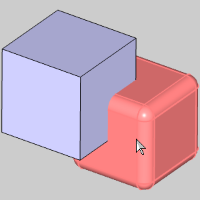
-
Click the cube to add it to the Surface/Solid to Union Together list.
The cube is selected, and is added to the Solid/Surface Bodies to Union Together list.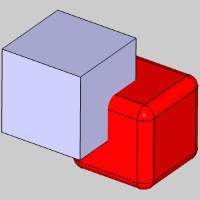
-
Hover over the second cube as seen in the image below.
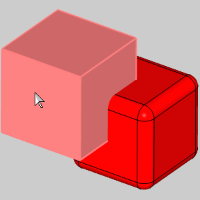
-
Click the cube to add it to the Surface/Solid to Union Together list.
The cube is selected, and is added to the Solid/Surface Bodies to Union Together list.
-
Click Show Preview to see a preview of the end result.
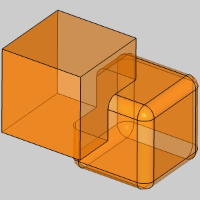
-
Click the OK to finalize the result.
The two cubes are added together and a Boolean
feature is created in the
Boolean
feature is created in the  CAD Tree.
CAD Tree.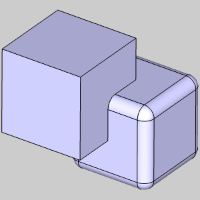
-
Hover over either cube.
With the cubes added together, the newly created solid highlights as one.
-
To end the function, click Cancel.
This concludes the example.
Example Boolean Subtract
This example will demonstrate how to use the Boolean Subtract function.
Note: In the images below, both the Show Axis X-Y and Show Gnomon toggles have been disabled in the Axis X-Y group of the Settings Part > Display dialog.
-
In the Quick Access Toolbar, click
 New.
New.
A new document opens. -
Enter into an ISO 2 view by pressing Ctrl+7.
-
In the Primitives group, of the Create 3D tab, click
 Cube.
Cube.
The Cube parameters display in the Data Entry Manager.
The Preview appears.
-
The first cube being created will be left at the default size, and location.
Click OK to confirm the first cube.
The Cube is created in the graphics area and a Cube feature is created in
the
Cube feature is created in
the  CAD
Tree.
CAD
Tree.
-
In the Origin group, change the values to X-1.0000, Y1.0000, Z1.0000.
The Preview updates.
-
Click OK to confirm the second cube.
The Cube is created in the graphics area and another Cube
feature is created in the
Cube
feature is created in the  CAD Tree.
CAD Tree.
-
In the Corners group, of the Create 3D tab, click
 Solid Fillet.
Solid Fillet.
The Solid Fillet parameters display in the Data Entry Manager. -
In the Solid Fillet parameters, click Whole Solid.
This will allow us to apply the fillet to every edge of the solid at once. -
Hover over the first cube as seen in the image below.

-
Click the cube to select it.
The cube is selected.
-
Click OK to confirm the fillet.
The fillet is created and a SolidFillet
feature is created in the
SolidFillet
feature is created in the  CAD Tree.
CAD Tree.
-
In the Solid Boolean group, of the Create 3D ribbon, click the down arrow under
 Boolean, and select
Boolean, and select  Subtract.
Subtract.
The Boolean parameters display in the Data Entry Manager.
Subtract is automatically selected as the function in use.
The Main Solid/Surface Body list is automatically given focus to allow selection of the main surfaces or solids to subtract from. -
Hover over the first cube as seen in the image below.

-
Click the cube to add it to the Main Solid/Surface Body list.
The cube is selected, and is added to the Main Solid/Surface Body list.
Focus is automatically shifted to the Solid/Surface Bodies to Subtract list to allow us to add solids and surface bodies to delete from the main body.
-
Hover over the second cube as seen in the image below.

-
Click the cube to add it to the Solid/Surface Bodies to Subtract list.
The cube is selected, and is added to the Solid/Surface Bodies to Subtract list.
-
Click Show Preview to see a preview of the end result.

-
Click the OK to finalize the result.
The intersecting portion of the two cubes is removed from the main body, and a Boolean feature is created in the
Boolean feature is created in the
 CAD
Tree.
CAD
Tree.
-
To end the function, click Cancel.
This concludes the example.
Example Boolean Intersect
This example will demonstrate how to use the Boolean Intersect function.
Note: In the images below, both the Show Axis X-Y and Show Gnomon toggles have been disabled in the Axis X-Y group of the Settings Part > Display dialog.
-
In the Quick Access Toolbar, click
 New.
New.
A new document opens. -
Enter into an ISO 2 view by pressing Ctrl+7.
-
In the Primitives group, of the Create 3D tab, click
 Cube.
Cube.
The Cube parameters display in the Data Entry Manager.
The Preview appears.
-
The first cube being created will be left at the default size, and location.
Click OK to confirm the first cube.
The Cube is created in the graphics area and a Cube feature is created in
the
Cube feature is created in
the  CAD
Tree.
CAD
Tree.
-
In the Origin group, change the values to X-1.0000, Y1.0000, Z1.0000.
The Preview updates.
-
Click OK to confirm the second cube.
The Cube is created in the graphics area and another Cube
feature is created in the
Cube
feature is created in the  CAD Tree.
CAD Tree.
-
In the Corners group, of the Create 3D tab, click
 Solid Fillet.
Solid Fillet.
The Solid Fillet parameters display in the Data Entry Manager. -
In the Solid Fillet parameters, click Whole Solid.
This will allow us to apply the fillet to every edge of the solid at once. -
Hover over the first cube as seen in the image below.

-
Click the cube to select it.
The cube is selected.
-
Click OK to confirm the fillet.
The fillet is created and a SolidFillet
feature is created in the
SolidFillet
feature is created in the  CAD Tree.
CAD Tree.
-
In the Solid Boolean group, of the Create 3D ribbon, click the down arrow under
 Boolean, and select
Boolean, and select  Intersect.
Intersect.
The Boolean parameters display in the Data Entry Manager.
Intersect is automatically selected as the function in use.
The Solid/Surface Bodies to Intersect list is automatically given focus to allow selection of the surfaces or solids to find the intersection between. -
Hover over the first cube as seen in the image below.

-
Click the cube to add it to the Surface/Solid Bodies to Intersect list.
The cube is selected, and is added to the Solid/Surface Bodies to Intersect list.
-
Hover over the second cube as seen in the image below.

-
Click the cube to add it to the Surface/Solid to Intersect list.
The cube is selected, and is added to the Solid/Surface Bodies to Intersect list.
-
Click Show Preview to see a preview of the end result.

-
Click the OK to finalize the result.
The intersecting portion of the two cubes are all that remains in the graphics area, and a Boolean feature is created
in the
Boolean feature is created
in the  CAD
Tree.
CAD
Tree.
-
To end the function, click Cancel.
This concludes the example.
 (Delete All)
- removes all entities from the Selected Geometry list.
(Delete All)
- removes all entities from the Selected Geometry list.